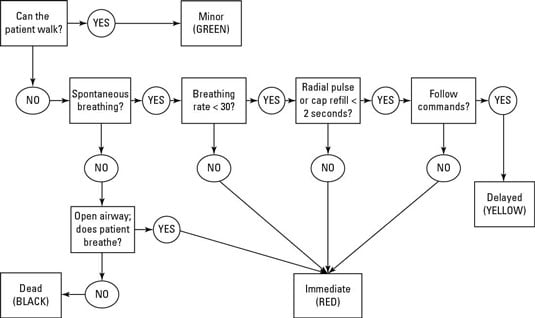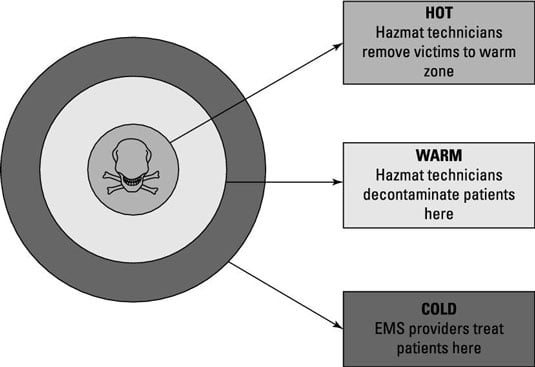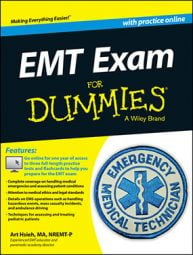You may find yourself faced with a large incident as an EMT. The NREMT exam will expect you to know how to approach large incidents, including triage and hazardous incidents.
Triage
Triage is a French word that means “to sort.” In mass casualty incidents, triage is used to decide which patient receives the most immediate care, who can wait to be treated, and, sadly, who is beyond help. Many EMS systems use a triage system called START, which stands for Simple Triage and Rapid Treatment.

START depends upon several basic parameters. The patients are categorized by severity as immediate, delayed, minor, and deceased; these correspond to colors on triage tags to enable rapid visual assessment of triaged patients.
Triage begins with directing patients who can walk under their own power to an area where they can be reevaluated for their actual injuries. These patients are categorized as “green” or minor. With the remaining, nonambulatory adult patients, you apply the following rules:
Is the patient spontaneously breathing?
If YES, go to Step 2. If NO, open the airway and reassess. If still not breathing, the patient is dead and categorized as BLACK. If the patient begins to breathe, then the patient is RED, or immediate.
Is the breathing rate less than 30 breaths per minute?
If YES, go to Step 3. If NO, then the patient is RED.
Is there a radial pulse, or is capillary refill less than 2 seconds?
If YES, go to Step 4. If NO, then the patient is RED.
Does the patient follow commands?
If YES, the patient is YELLOW, or delayed for treatment. If NO, then the patient is RED.
This process takes only a few seconds to apply, allowing you to triage a large number of patients in a short period of time. Triage tags or tape is used to label the patients as you process them.
An explosion has occurred at a local manufacturing plant. You are the triage officer. A patient walks up to you with an amputation of the right arm at the elbow. There is a pant belt looped around the remaining arm. It is oozing blood.
The patient’s skin is pale and cool to the touch; he is breathing 30 times per minute, and his radial pulse rate is 100. Using START triage, you would categorize this patient as
(A)black.
(B)green.
(C)yellow.
(D)red.
The best answer is Choice (B); as distressing as this patient’s injury is, he is walking and therefore triaged into the minor, or green, category. In the initial triage phase, he wouldn’t fit into any of the other categories. However, it’s likely that upon reaching the treatment area, he’ll be retriaged and probably moved into a more urgent category.
Hazardous incidents
The modern world is filled with a near-infinite number of chemicals that are used to make our lives better, safer, and more convenient. An unfortunate side effect is that many of them are also hazardous to health; companies worldwide spend billions of dollars to minimize spills and accidents.
EMS responds to hazardous events regularly. Unless you are specifically trained, equipped, and responsible for mitigating the hazard, your job is to notify others of a possible hazardous incident and keep unauthorized personnel from entering.
Operate only within the cold zone, where there is no contact with the hazardous material. Patients are decontaminated in the warm zone by specialists who are trained to perform this task. Hazmat technicians mitigate the actual problem within the hot zone.

Make sure patients are decontaminated before transporting them to hospitals. It does no good to bring the disaster to the emergency department!

